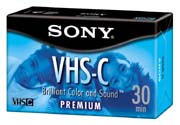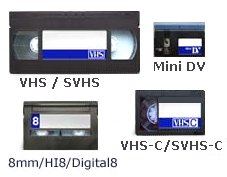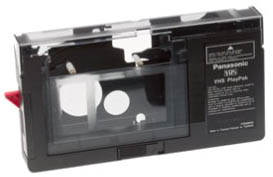VHS C tapes and video formats
VHS-C is the offshoot of VHS from 1983 and functioning basically as a home grade analog camera. Vintage VHS works with this format to convert your home movies into well preserved high-quality DVDs or Blurays. The VHS C format is rare than the standard VHS format, with many video conversion companies not even touching them.
In comparison with Video 8 functions, VHS-C has similar picture quality but less running time; around a halfhour at S.P>. 90 versus around a halfhour with SP speed on the normal cassettes; 180 versus 60 for longer-running modes.
The later Hi8 and VHS-C systems both have a quality similiar.

We convert all VHS formats on our Services page.

The VHS-C Format

In response to demand for smaller video cameras in the 1980s, Panasonic launched the VHS-C format. The VHS-C tape is basically a smaller version of a VHS tape — it uses the same type of tape but a smaller length (usually 30 to 60 minutes) in a smaller cassette.
The technical specifications are essentially the same as VHS, although the smaller mechanical parts in VHS-C camcorders do have a slight performance disadvantage compared to full-sized VHS.
Note: The S-VHS-C format is the same as VHS-C but uses S-VHS (Super VHS) tape.

VHS-C Cassette Adaptors
To playback a VHS-C tape in a normal VHS machine a battery-powered cassette adaptor is used. The VHS-C tape is inserted into the adaptor which threads the tape into a configuration just like a full-sized cassette. (link to assessories page)
VHS-C
The Video8 format was the main competitor for VHS-C during the 1980s. While Video8 was widely considered to be the better format, VHS-C had the strong advantage of being compatible with the ubiquitous VHS machine. Although Video8 did fare better than VHS-C overall, the two formats waged a relatively evenly-matched battle until the advent of digital video formats.
JVC introduced the VHS format in 1976 to go head to head with Sony's successful Betamax. Although inferior in image quality to BetaMax, it offered 2 hour recording time on a larger T-120 cassette, which was a major factor to the cost conscious home consumer - - - plus, an entire movie could be recorded onto one cassette. Ironically, much of the technology and engineering concepts for this format were originally developed by Sony, and offered for free to JVC. Guess hard lessons were learned, as Sony never made that mistake again !
Using sheer numbers as the sole metric, VHS is by far the winner and quickly became the premiere consumer format and another major landmark in video history !
VHS-C was nothing more than a smaller physical cassette size to allow for more compact camcorder design which came along somewhat later in the timeline. A simple adapter allows Vhs-C cassettes to be played back or recorded in any standard full size Vhs machine.
In its most simplistic form, the recording process in VHS occurs in the following order:
- Tape is pulled from the supply reel.
- Tape is passed through the erase head - wiping existing recording from the tape.
- Tape is placed onto the head drum, using more than 180-degrees of the drum.
- Video is applied by the tape heads, to the tape, in a diagonal angle.
- Audio and control tracks are applied to the tape.
- The tape is then sent to the take-up reel.
Erase head
In VHS, the tape contains a mixture of magnetic oxide particles that can be arranged to encode video and audio signals. The erase head is a mini transducer that simply randomizes the magnetization of the tape.21 By scattering or randomizing the particles on the tape, anything recorded on it is erased. This allows for the recording process to apply video and audio to a clean tape surface. In purely theoretical terms, the oxide does not wear off with repeated erasing. However, in real-world conditions, physical changes are made to the tape every time the tape is played, such as stretching or wear. The best method in erasing tapes is to use a bulk eraser, which erases a tape without any moving parts.
Video recording

A typical VHS head drum containing two tape heads. (1) is the upper head, (2) is the tape heads, and (3) is the head amplifier.

The underside of a typical 4-head VHS head assembly showing the head chips.
Once the tape has been erased of possible previous recordings, the tape is wrapped against the head drum a little more than 180-degrees (called the omega transport system) in a helical fashion, assisted by the slanted tape guides. Because the head-wheel is constantly rotating at a speed of 1800 rpm (1500 rpm for PAL,) the video must be recorded to the tape in a ±7-degree angle, so that the tape doesn't have to stop while the video track is applied. The video tracks are recorded diagonally, so the head drum must also be positioned in the same ±7-degree angle. The video recording process uses a slant azimuth recording method - a type of helical scan recording. Each of the diagonal-angled tracks is a complete TV picture field, lasting 1/60th of a second (1/50th on PAL) on the display. One tape head records an entire picture field. The adjacent track, recorded by the second tape head, is another 1/60th or 1/50th of a second TV picture field, and so on. To maximize the use of the tape, the video tracks are recorded very close together to each other. The original VHS specification had only two tape heads; later models implemented more tape heads, which improved recording performance.
VHS tapes have approximately 3 MHz of video bandwidth and 400 kHz of chroma bandwidth, which is achieved at a relatively low tape speed by the use of helical scan recording of a frequency modulated luminance (black and white) signal, with a down-converted "color under" chroma (color) signal recorded directly at the baseband. Each helical track contains a single field ('even' or 'odd' field, equivalent to half a frame) encoded as an analog raster scan, similar to analog TV broadcasts. The horizontal resolution is 170 lines per scanline, and the vertical resolution (the number of scanlines) is the same as the respective analog TV standard (576 for PAL or 486 for NTSC; usually, somewhat fewer lines are actually visible due to overscan). In modern-day digital terminology, NTSC VHS is roughly equivalent to 333x480 pixels luma and 40x480 chroma resolutions (333x480 pixels=159,840 pixels or 0.16MP (1/6 of a MegaPixel)).,22 while PAL VHS offers the equivalent of about 335x576 pixels luma and 40x240 chroma (the vertical chroma resolution of PAL is limited by the PAL color delay line mechanism).
JVC would counter 1985's SuperBeta with VHS HQ, or High Quality. The frequency modulation of the VHS luminance signal is limited to 3 megahertz which makes higher resolutions technically impossible even with the highest-quality recording heads and tape materials, but an HQ branded deck includes luminance noise reduction, chroma noise reduction, white clip extension, and improved sharpness circuitry. The effect was to increase the apparent horizontal resolution of a VHS recording from 240 to 250 analog (equivalent to 333 pixels from left-to-right, in digital terminology). The major VHSOEMs resisted HQ due to cost concerns, eventually resulting in JVC reducing the requirements for the HQ brand to white clip extension plus one other improvement.
In 1987, JVC introduced a new format called Super VHS which extended the bandwidth to over 5 megahertz, yielding 420 analog horizontal (560 pixels left-to-right). Most Super VHS recorders can play back standard VHS tapes, but not vice versa. Because of the limited user base, Super VHS was never picked up to any significant degree by manufacturers of pre-recorded tapes.
VHS-C
VHS-C is the compact VHS format introduced in 1982 and used primarily for consumer-grade compact camcorders. The format is based on the same videotape as is used in VHS, and can be played back in a standard VHS VCR with an adapter. Though quite inexpensive, the format is largely obsolete even as a consumer standard and has been replaced in the marketplace by digital video formats, which have smaller form factors.
The magnetic tape on VHS-C cassettes is wound on one main spool and used a gear wheel which moves the tape forward. It can also be moved by hand. This development hampered the sales of the Betamax system somewhat, because the Betamax cassette geometry prevented a similar development.
VHS-C was one of the pioneering formats of the compact camcorder market, and was released to compete with Video8. VHS-C cassette was larger than Video8 cassette, but was compatible with VHS tape recorders. A higher quality version of VHS-C was released, based on S-VHS, known as S-VHS-C, that competed against Hi8, the higher quality version of Video8. The arrival on the market of inexpensive S-VHS-C camcorders led to the inclusion on many modern VCRs of a feature known as SQPB, or SuperVHS Quasi-PlayBack, but did not make a significant impact on the market as the arrival of MiniDV as a consumer standard made low-cost, digital, near-broadcast-quality video widely available to consumers, and rendered analog camcorders largely obsolete.
Compared with Video8, VHS-C had identical video quality but a shorter run time, 120 versus 40 minutes at SP speed, 240 versus 120 for longer-running modes. Although at one time JVC marketed a 45-minute and a 60-minute SP Mode tape with the Extra High Grade formulation (135 minutes, and 180 minutes in EP/SLP Mode). Hi8 and S-VHS-C both have laserdisc quality pictures, but media is far less readily available than the cameras themselves, and thus most S-VHS-C units support S-VHS ET, which allows recording of an S-VHS signal on high-grade VHS tape.
Although Video8 acquired a digital variant, Digital8, it is extremely unlikely that D-VHS will ever be adapted to a compact format, as the consumer camcorder industry has largely standardized on small-format MiniDV and the new hard drive based recorders. As of 2010, a few VHS-C and S-VHS-C camcorders are still available from JVC at extremely low prices (~US$200), and the media remains widely-available at relatively low cost.
Some of the other Answers may have missed your main point (VHS-Compact format – not regular VHS tape), but the general idea is if you're happy with "home movies" and staying with a tape-based collection, there's no reason for you to switch to the 8cm DVD format.
Besides, much like VHS and the camcorders that record in that format, the "mini DVD" camcorders have also become passé. Before solid-state memory (internal flash and removable flash-card) and small hard drives became more-affordable (as they are now) the 8cm size DVD was the only way camcorder manufacturers could get Gigabyte-range storage inside a small form-factor. "Going to mini-DVD" isn't exactly keeping up with the times. Last time I shot in VHS-C was 1998, but I still use my Hi-8 & Digital-8 camcorders and editing decks for low-budget and home-project recording. (And like you, I can find 8mm blank tapes VERY cheap as "closeouts" and on eBay!)
I'm glad you can still find VHS-C blanks in your area (and hopefully you have one or more of the VHS-C to VHS tape cassette adapters to play in full-size home players), but even tapes and tape-heads deteriorate over time.
As your equipment ages and as stores' stock of VHS-C (and even regular VHS) becomes less-available, you might switch over to either mini-DV tape (which is widely used professionally, so will be around quite a while longer – and has better quality than most of the "card/HDD digital" formats) and look for a model that has "one-button" burn-to-DVD capability (some JVC models use an affordable DVD external-drive, or one of your own DVD recorders for archiving). That way you'll have an archive format that will last without mechanical wear & tear.
VHS-C recording options: Another variant is VHS-Compact (VHS-C), originally developed for portable VCRs in 1982, but ultimately finding success in palm-sized camcorders. The longest tape available for NTSC holds 60 minutes in SP mode and 180 minutes in EP mode. Since VHS-C tapes are based on the same magnetic tape as full size tapes, they can be played back in standard VHS players using a mechanical adapter, without the need of any kind of signal conversion. The magnetic tape on VHS-C cassettes is wound on one main spool and uses a gear wheel to advance the tape.
The adapter does not require a battery to function and is solely a mechanical adapter. It has an internal hub to engage with the VCR mechanism in the location of a normal full-size tape hub, driving the gearing on VHS-C cassette. Also when a VHS-C cassette is inserted into the adapter, a small swing-arm pulls the tape out of the miniature cassette to span the standard tape path distance between the guide rollers of a full-size tape. This allows the miniature cassette to use the same tape loading mechanism of the full-size tape.
Super VHS-C or S-VHS Compact was developed by JVC in 1987. S-VHS provided an improved luminance and chrominance quality, yet S-VHS recorders were compatible with VHS tapes.25
Sony Betamax was unable to shrink that form any further, so instead they developed Video8/Hi8 which was in direct competition with the VHS-C/S-VHS-C format throughout the 80s, 90s, and 2000s. Ultimately neither format "won" and both continue to be sold in the low-end market (examples: JVC SXM38 and Sony TRV138).
VCR VHS C tape conversion
Vintage VHS has many conversion packages for video tapes and VHS C duplication. For as low as $14.99; we can convert your videos with many additional features that you got to see to believe! Visit our tape conversion page today!